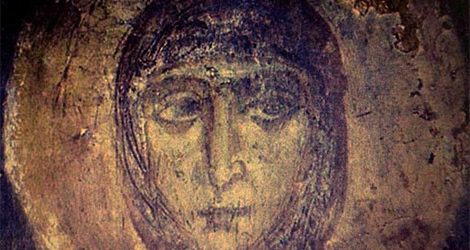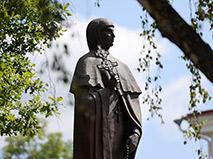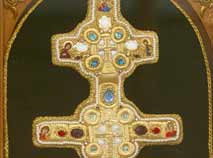Euphrosyne of Polotsk

Euphrosyne of Polotsk. A fresco
Euphrosyne (or Efrosinia) of Polotsk is regarded as a patron saint of Belarus.
Euphrosyne of Polotsk was born between 1101 and 1104 in the family of Prince Svyatoslav-Georgy, second son of Vseslav the Sorcerer.
In secret, the princess took the veil and the new name of Euphrosyne.
Reverend Euphrosyne founded a convent and a friary, which became centres of enlightenment in the Polotsk principality. She contributed to the rebuilding of the Sofia Cathedral and the work on the Polotsk chronicles. A cross Euphrosyne had made bearing her name is a unique masterpiece of the ancient Belarusian applied art.
Euphrosyne also composed music, and is regarded as the first Belarusian art patron. Under her direction and using her money, the Saviour Church was built in the 1150s. It is the finest example of the Polotsk architectural school. Her name is connected with the emergence of the Madonna icon known as Hodigitria of Polotsk, which was brought from Byzantium.
The calming influence of this woman of faith also helped to heal the historical enmity between the Polotsk and Kiev principalities. Late in her life Euphrosyne of Polotsk went to Jerusalem on a pilgrimage. During the trip she fell ill and died in 1173.
She was buried in a monastery not far from Jerusalem. In 1187 her relics were transported to the Kiev Pechersk Lavra, and in 1910 moved again to Polotsk, where they are now.
On 5 June Orthodox Christians celebrate the Feast Day of St. Euphrosyne of Polotsk, the heavenly intercessor of the Belarusian land. This is the only day of the year when a festive service is held in St. Sophia Cathedral. After the solemn liturgy, a procession passes from the cathedral to the Saviour and St. Euphrosyne Convent founded (1125) by Euphrosyne herself. Once upon a time, the famous hegumenia followed exactly the same path. St. Euphrosyne of Polotsk is equally revered by both Orthodox and Catholics.







 print version
print version make home page
make home page add to bookmarks
add to bookmarks









